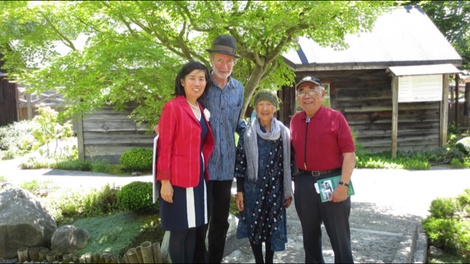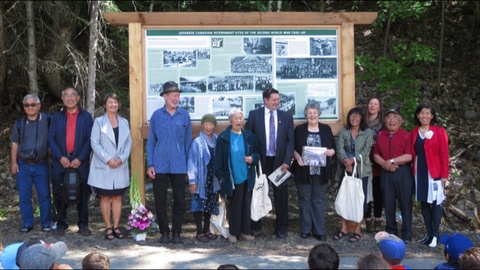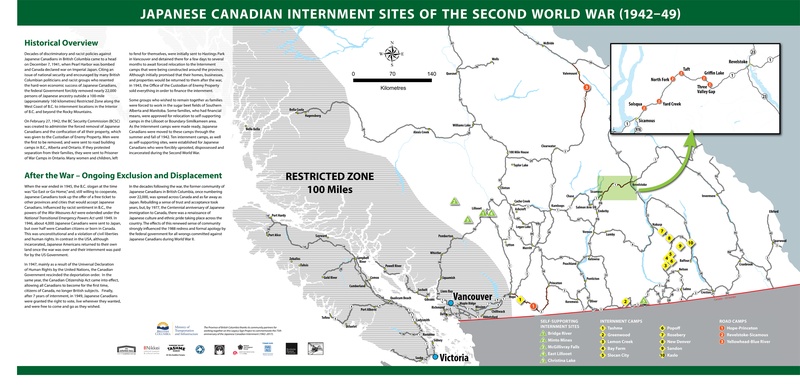Certainly one of the most important Japanese Canadian projects that was completed in 2018 was the Highway Legacy Sign Project in British Columbia (BC), Canada. The ambitious eight site project included important reminders that Nisei and Issei men worked as forced labour to build highways in some of the most remote and dangerous areas of BC and Alberta.
In September 2018, the Ontario JC heritage marker program was launched. The first one highlighted a little-known chapter of Japanese Canadian history in Mitchell’s Bay in the Chatham-Kent area where Japanese Canadian families from BC were sent as farm labourers during and after WW2 under the Ontario Farm Labour Force Program. Four more Ontario locations were slated to get interpretative signage, one at the Lambton-Kent Memorial Agricultural Centre in Dryden, the English Farm at 8907 Doyle Line in Chatham, Talbot Trail in Eatonville and 4405 Middle Line in Valetta, and the Tilbury East Municipal Shop location.
As I perused the book Japanese Canadian Internment in the Second World War by Pamela Hickman and Masako Fukawa, one passage caught my eye. June Fujiyama, recalled her brother, Taro’s harrowing experience. He was detained by police and his car impounded after visiting a friend a few days after Japan’s attack on Pearl Harbor. After that, his family did not hear from him for more than six months. He had been sent to a road camp where the conditions were deplorable “… if there was any protest about the living arrangements or the dangerous working conditions, such as a drunken powder man, the threat was ‘you’ll be sent east.’ For most men it was enough to keep them quiet since being sent to Ontario meant leaving their families behind in BC.” Taro was in the first group of men sent to the Yellowhead-Blue River Highway road camp based in Decoigne, Alberta.
Hamilton, Ontario’s Bryce Kanbara, son of an Angler POW camp prisoner and Nisei Mass Evacuation Group (NMEG) leader, Tameo Kanbara, added: “NMEG's resistance was based on their objection to families being split up and their refusal to go to road camps. Nisei who defied the government orders to report for enlistment to road camps were pursued, arrested and sent to Angler POW camp in northern Ontario.”
The artist/owner of the You Me Art Gallery in Hamilton, Ontario, Kanbara said: “My father and my uncle Yukio Shimoda began the NMEG movement. My other uncles, Yukio's younger brothers, Haruo, and Mits Shimoda, refused to register for road-camp duty and were also guests at the Angler Hotel. All are now deceased.” Kanbara’s remarks offer a hint about those tumultuous times; either agree to work on the road camps or face imprisonment at Angler or Petawawa POW camps in Ontario. Many took a principled stand and became prisoners of war.
It is also important to remember that of the 21,079 persons of Japanese descent that were living within the 100 mile “protected area” of the BC coast on October 31st, 1942, they were dispersed as follows: 986 road camps,3,988 sugar beet farms in Alberta, Manitoba and Ontario, 11,694 interior BC housing projects, 1,161 self-supporting projects, 431 independent and industrial projects, 1,337 special permits, fourty-two (to the ‘filthy and desolate barracks’ in Uraga, Japan, 579 voluntary relocation before 1942, 699 internment in Angler POW camp,fifty-seven detention in Vancouver, and 105 the Hastings Park hospital. While the usual focus of our community stories is about telling of those of the camps, Greenwood, Kaslo, Lemon Creek, Bayfarm, Popoff, Sandon, New Denver, Slocan, each has their own compelling stories to tell. We mustn’t ever forget them.

From left: Laura Saimoto, JC Legacy Committee chair; Paul Gibbonsr; Koko Gibbons (Kokubo), residents New Denver; Basil Izumi (Vancouver resident, New Denver Internee). Photo courtesy of Laura Saimoto.
I was able to ask Laura Saimoto, chair of the Japanese Canadian Legacy Project Committee about this important project.
So, going back to the beginning, Laura, what initially got this ambitious BC project going?
The Highway Legacy Sign Project was an outgrowth of the Japanese Canadian Historic Sites registry project, which announced fifty-six Japanese Canadian historic sites on a provincial online heritage registry by the Ministry of Multiculturalism and Heritage Branch on April 1, 2017. As part of the seventy-fifth commemorations of the internment. Japanese Canadian community organizations in the Lower Mainland united to form the Japanese Canadian Legacy Committee, a coalition of community organizations to drive this registry.
Given that historic signage at the physical locations of the internment camps had been a community dream for decades, our committee proposed using the registry as a springboard to propose a plan to the Ministry of Transportation and Infrastructure (MOTI) to erect interpretative signage at the actual internment sites and road camp locations as part of the seventy-fifth anniversary commemorations. In September of 2017, the new Minister of Transportation, Claire Trevena, committed to eight interpretive signs at the internment and road camp clusters, as well as three stop of interest Signs. Our committee would be responsible for the content of the signs, and the MOTI would pay for the signs and their installation on MOTI property. We erected the first sign on Oct. 27, 2017, at the Tashme Internment Site and for the past year, completed installing eight interpretative signs and three stop of interest signs in partnership with the provincial government.
Who is the Japanese Canadian Legacy Project Committee? Do you have a personal connection to this story?
The Legacy Committee consisted of representatives from the major Japanese Canadian community organizations in the Lower Mainland. I serve on the board of directors at the Vancouver Japanese Language School and Japanese Hall and I am chair of the committee. The Nikkei National Museum, Tashme Museum and Historical Society, Tonari Gumi, Nikkei Legacy Park in Greenwood, and the Lillooet Seniors’ Committee were the active members of the committee who did a tremendous amount of work to make this project happen.
Our committee launched a year-long fundraising campaign to raise funds to host the unveiling events and to partner with the local communities where the signs would be installed and to involve as many local schoolchildren as possible. The committee’s primary goal was education, and this meant partnering with local communities to educate and own the lessons of our history using the signs.
Both sides of my family were interned, my mom’s side in Bridge River and East Lillooet, and my dad’s side of the family in Minto, then Revelstoke. My parents talked about their internment experience at home and held the vision that someday, we would have permanent markers at the internment sites so our history would not be forgotten where it happened. This always stuck with me. As my parents’ generation is almost gone, we felt that the seventy-fifth anniversary was now the time to make this legacy education project become a reality! So we made a great push to pitch our plan to the provincial government and to the community to support it.
How were the road campsites chosen? Were there others that weren’t chosen?
On the Historic Site Registry, fifteen internment sites and three road camps were recognized, so we asked for eighteen signs. As a middle ground, we agreed with MOTI to group the internment sites into eight clusters based on proximity. The sign content would tell the history of all eighteen sites on eight interpretative signs.
Were there any stumbling blocks along the way? If so, what were they?
The dedication and commitment of our committee members and our local community partners were amazing and drove the project forward, in spite of a few stumbling blocks. In the end, we went far beyond what we initially envisioned. Our project was something totally outside the box, and crossed several ministries and bridged both a Liberal and a new NDP government with new staff. So cross-ministry and realignment of ministries communication and coordination was challenging. However, with dogged persistence and determination, we partnered with the BC government to get the job done.

© 2019 Norm Ibuki







